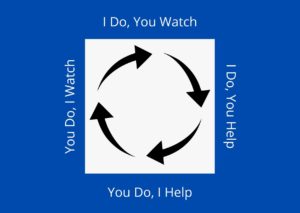
**This article is inspired by chapter 10 of John C. Maxwell’s book “Developing the Leaders Around You” – “The Leader’s Lasting Contribution: Reproducing Generations of Leaders” ***
A fatal flaw of many leaders is holding the assumption that next-generation leaders will simply show up without any developmental effort. The reality is that these new leaders must be intentionally developed over time. Sure, you can recruit young leaders to your team from the outside, but someone has to invest in them along the way for them to show up that way.
In the graphic above, you will see a simple (but not easy) 4-step process for developing leaders for the future. These four steps have been taught and utilized for years in various ways by a variety of leaders, but let this graphic be a tool to help you remember what you can (and must) do if you are going to leave a legacy of success in your organization long after you’re gone.
There’s one more step beyond these four that is critical as well if you are going to develop a pipeline of next-generation leaders. Keep reading to gain a better understanding of the four steps + the critical next step that is often overlooked.
Step #1 – I Do, You Watch
In this phase, you are simply allowing your developing leader to observe what you do and how you do it. They don’t have any responsibilities other than shadowing you for a period of time. The amount of time you stay in this phase depends on the complexity of what you’re training them to do. It could take minutes, weeks, or months. Predetermine an estimated timeline and communicate it upfront in order to manage expectations.
Step #2 – I Do, You Help
In this phase, your developing leader begins to assist you. Prepare to spend a significant amount of time in this phase. You are responsible for the project and they are responsible for helping you achieve your desired results. This phase will most likely have sub-phases as their skills and understanding increase. You will hand off more and more tasks to them to assist you as time goes on. As stated in Step #1, the amount of time you stay in this phase depends on the complexity of what you’re training them to do.
Step #3 – You Do, I Help
In this phase, you simply switch roles in the project. You are both involved to achieve results, but the developing leader is now taking the lead. You are assisting him or her. This gives them the support and training they need while also being empowered to take ownership and make decisions. Once again, the amount of time you stay in this phase depends on the complexity of what you’re training them to do.
Step #4 – You Do, I Watch
Once you’ve successfully navigated the previous three steps, you are able to step back while the developing leader runs with the project and takes full responsibility. You serve as a mentor and sounding board, but you are hands-off as much as possible. Resist the temptation to step in and do it your way or fix things that they simply need to learn to correct on their own. Be a voice of support and wisdom, but stay out of the project. It is theirs to own and produce results.
Step #5 – Challenge Your New Leader To Train Others
This is a key step that is often neglected in this developmental process. It’s not enough to simply train a developing leader; you must also challenge him or her to pass it on to others. You’ve just led them through a transformative process to become a capable, empowered leader. Now it’s time for them to do the same. Challenge them to identify their next-generation leader whom they can train as you did for them. And make sure they don’t let the process of developing next-generation leaders stop with that person. When done well, this process can be a powerful process that reproduces leader after leader.
One word of warning: this process is not usually fast or easy. That’s why so many leaders neglect it. However, if you will invest in the upfront effort, you will reap long-term benefits personally and organizationally. The best leaders develop other leaders who can move the organization or cause forward once they move on or retire. You can be that kind of leader if you will commit to working through this process over and over.
Are you up for it?
If so, begin today by identifying your first potential leader and begin the “I Do, You Watch” phase and then advance forward with intention through the other steps.
Until next time…make today GREAT!
